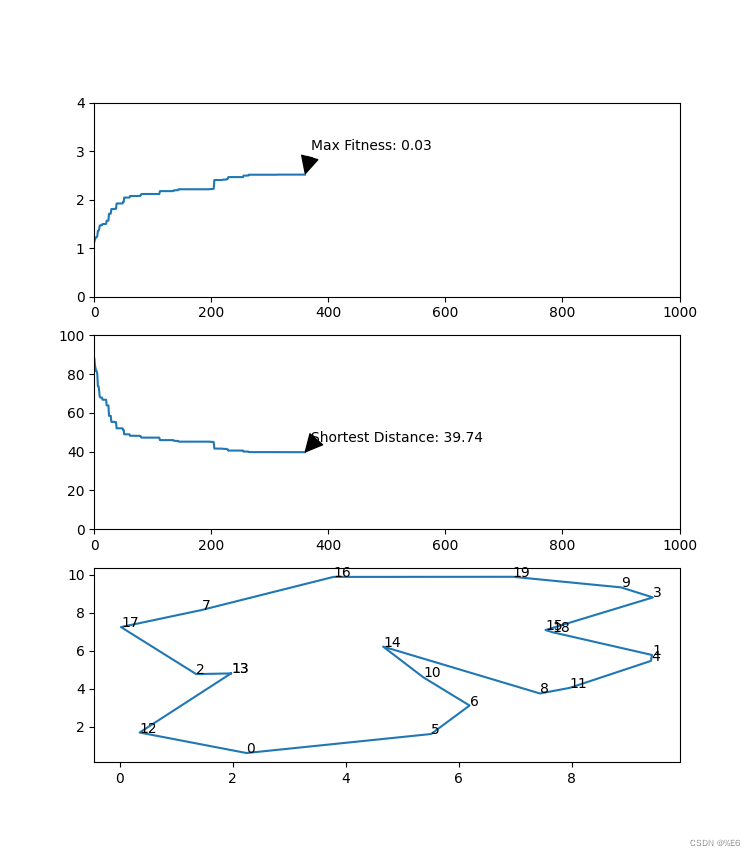遗传算法(GA),旅行商问题(TSP)python numpy
import numpy as np
import matplotlib.pyplot as plt
def citys_points(m, n=2):
citys = np.round(np.random.uniform(0, 10, size=(m, n)), decimals=4)
np.savetxt('citys.txt', citys, delimiter=',')
return citys
def init(citys, pop_size=100):
[m,n] = np.shape(citys)
init_pop = np.zeros((pop_size, m))
arr1 = np.arange(0, m)
for i in range(pop_size):
np.random.shuffle(arr1)
init_pop[i, :] = arr1
init_pop = np.concatenate([init_pop, init_pop[:, 0].reshape(pop_size, 1)], axis=1)
return init_pop
def get_fitness(pop, citys):
[pop_size, num_genes] = np.shape(pop)
distance = np.zeros((pop_size))
for i, row in enumerate(pop):
for index, item in enumerate(row):
if index == 20:
break
p1 = citys[int(item)]
p2 = citys[int(row[index + 1])]
x1, y1 = p1[0], p1[1]
x2, y2 = p2[0], p2[1]
distance[i] += np.sqrt((x2 - x1)**2 + (y2 - y1)**2)
fitness = 1/distance
fitness_max_index = np.argmax(fitness)
fitness_max_item = fitness[fitness_max_index]
best_route = pop[fitness_max_index]
shortest_distance = distance[fitness_max_index]
return fitness,fitness_max_item,shortest_distance,best_route
def roulette_select_pop(pop,citys):
[pop_size, num_genes] = np.shape(pop)
res = get_fitness(pop, citys)
fitness = res[0]
fit_max = fitness.max()
fit_min = fitness.min()
fitness_nomal = (fitness - fit_min)/(fit_max - fit_min)
fitness_prob = fitness_nomal/(np.sum(fitness_nomal))
fitness_prob_cumsum = np.cumsum(fitness_prob)
seed = np.random.rand(pop_size)
choosen_seed = np.sort(seed)
choosen_pop = np.zeros((pop_size, 21))
i = 0
j = 0
while i < pop_size:
if choosen_seed[i] < fitness_prob_cumsum[j]:
choosen_pop[i, :] = pop[j, :]
i = i + 1
else:
if j == 99:
break
j = j + 1
return choosen_pop
def cross_gene(pop, p):
pop = np.delete(pop, 20, axis=1)
[pop_size,num_genes] = np.shape(pop)
for i in range(0, pop_size, 2):
if np.random.rand() < p:
gene_part = pop[i, 8:12].copy()
index_item_arr = np.where(np.isin(pop[i + 1, :], gene_part))
np.random.shuffle(index_item_arr)
for j in range(len(gene_part)):
pop[i,8+j] = pop[i+1][index_item_arr[0][j]]
pop[i + 1, index_item_arr[0][j]] = gene_part[j]
pop = np.concatenate((pop, pop[:, 0].reshape(100, 1)), axis=1)
return pop
def mutation(pop, p):
pop = np.delete(pop, 20, axis=1)
for index,row in enumerate(pop):
if np.random.rand(1) < p:
points_muta = np.random.randint(0, 20, size=(2))
gene1 = row[points_muta[0]].copy()
row[points_muta[0]] = row[points_muta[1]]
row[points_muta[1]] = gene1
pop[index,:] = row
return np.concatenate((pop, pop[:, 0].reshape(100, 1)), axis=1)
def next_pop():
pass
if __name__ == "__main__":
m = 1000
p_cross = 0.6
p_muta = 0.4
citys = citys_points(20)
init_pop = init(citys)
arr_fitness_max = np.empty(0)
arr_shortest_distance = np.empty(0)
fig, axs = plt.subplots(3, 1)
plt.ion()
for i in range(m):
[fitness, fitness_max, shortest_distance, best_route] = get_fitness(init_pop, citys)
arr_fitness_max = np.append(arr_fitness_max, fitness_max * 100)
arr_shortest_distance = np.append(arr_shortest_distance, shortest_distance)
axs[0].cla()
axs[0].plot(np.arange(i + 1), arr_fitness_max)
axs[0].set_xlim((0, m))
axs[0].set_ylim((0, 4))
axs[0].annotate(f'Max Fitness: {fitness_max:.2f}', xy=(i, fitness_max*100), xytext=(i+10, fitness_max*100+0.5), arrowprops=dict(facecolor='black', shrink=0.05))
axs[1].cla()
axs[1].plot(np.arange(i + 1), arr_shortest_distance)
axs[1].set_xlim((0, m))
axs[1].set_ylim((0, 100))
axs[1].annotate(f'Shortest Distance: {shortest_distance:.2f}', xy=(i, shortest_distance), xytext=(i+10, shortest_distance+5), arrowprops=dict(facecolor='black', shrink=0.05))
x = [citys[int(i)][0] for i in best_route.astype(int)]
y = [citys[int(i)][1] for i in best_route.astype(int)]
axs[2].cla()
axs[2].plot(x, y)
for j, txt in enumerate(best_route.astype(int)):
axs[2].annotate(txt, (x[j], y[j]))
plt.pause(0.2)
roul_pop = roulette_select_pop(init_pop, citys)
cross_pop = cross_gene(roul_pop, p_cross)
muta_pop = mutation(cross_pop, p_muta)
new_pop = np.concatenate((muta_pop[:-1, :], best_route.reshape(1, 21)), axis=0)
print(new_pop)
init_pop = new_pop
plt.ioff()
plt.show()
























 870
870











 被折叠的 条评论
为什么被折叠?
被折叠的 条评论
为什么被折叠?








